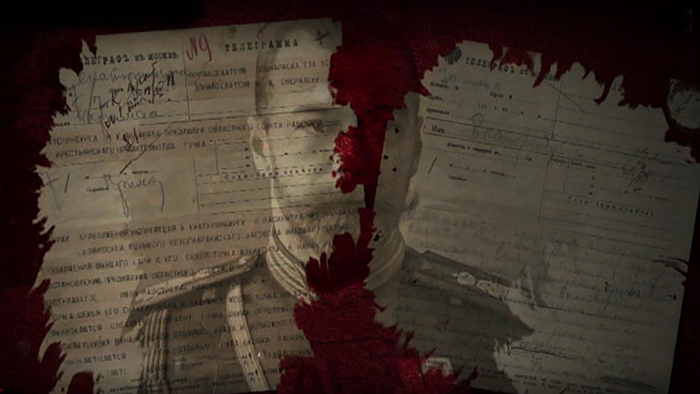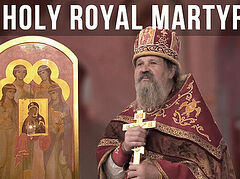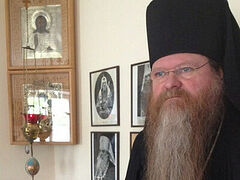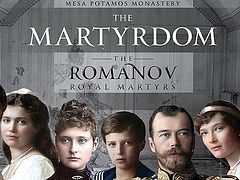On July 19, the television channel Russia-1 showed the second film in the cycle, “The Murder of the Romanovs,” shedding light on one of the most tragic pages in the history of the Russian state. The first film, “Regicide: A Century-long Investigation” tells about the origins of the investigation into the murder of the Royal Family. The second part, “Murder of the Romanovs: Facts and Myths”—a painstaking research work by E. N. Chavchavadze and G. I. Ogurnaya—introduces the viewer to unique archival documents.
We are speaking with the documentary filmmaker and honored artist Elena Nikolaevna Chavchavadze.
The interviewer was kindly given the opportunity to get acquainted with the film materials before its release.
—Elena Nikolaevna, tell us about the background of making these films dedicated to the Royal Family. How did it all begin?
—Part of the code of honor for me and my family is to always seek the truth in everything. By the time we started working on the films on the murder of the Romanov Dynasty for the TV channel Russia, we had already filmed five episodes of the series, “Romanovs: A Royal Matter,” “War and Peace of Alexander I,” “Alexander III: Strong, Powerful.” The material itself showed us which direction to go next. And it was impossible to avoid the topic of regicide.
I was worried, realizing that the topic is too big. Let’s recall the words of Voykov who said: “The world will never find out what we did to them.” This is a challenge to researchers. Is it possible to unravel this tragic mystery? But you know how it is: Fear has big eyes. As far as I know, a number of fundamental studies by anthropologists, criminologists, geneticists, graphologists, and other scientists are nearing completion. And we hope that the next film in the cycle will be dedicated to the results of this long-term work.
—Your film is called, “Murder of the Romanovs: Facts and Myths.” I’d like to dwell on this in more detail. What is a fact and what is a deliberately created myth? The film quotes Lenin’s words: “We don’t need to tell Joffe the truth (about the murder), so it will be easier for him to lie later.”
—We tried to clearly show the mechanism by which a myth turns into fact, and a fact becomes a myth and dissolves with time.
I must say that the plan of “blurring” the truth worked on a global level. All the Bolsheviks’ negotiations and diplomatic correspondence was constructed so as to divert suspicion away from the top of the soviet leadership. This is a very thoughtful, masterly calculation. Only such a position would have allowed them to remain in power, as at that time they were entirely dependent upon Germany.
And how “interesting” the newspaper articles were! How well they were edited—again with an understanding of the colossal power of influence on the public consciousness! It’s in the papers, so it must be true.
When the investigator Sokolov managed, with much difficulty, through Prince Orlov’s agency In Russia, to get an agitation pamphlet talking about the murder of the Royal Family while he was in France, he included it to the case. But this primitive article, intended for the proletariat, had been carefully edited by someone by then. We don’t know who the editor was, but probably it was Pokrovsky, a famous falsifier of history. But he was certainly a very astute man. But unfortunately, Sokolov took it all at face value. And today many people adhere to the theory that was presented in his book, because it was the only work on the topic of regicide at the time. And given that the book was created under certain conditions, under the pressure of the circumstances, and on the basis of such obviously unreliable documents, who will figure out the truth? The investigator Sokolov did a great job, and no one belittles the significance of his works for history. But, you know, the details settle everything.
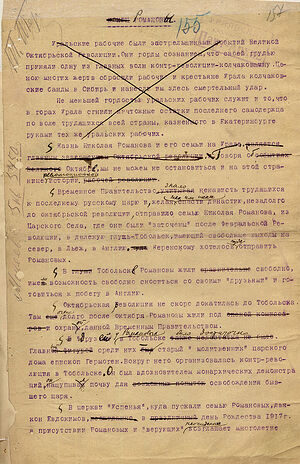 —Unfortunately, the majority form their personal opinion not based on documents, not on the materials of the investigation, but on articles in the press and online. How many books have been written justifying this or that theory!
—Unfortunately, the majority form their personal opinion not based on documents, not on the materials of the investigation, but on articles in the press and online. How many books have been written justifying this or that theory!
—And therefore, I think it’s necessary to dive into the archival material, to compare facts. Who was familiar with whom and when; where could this or that declaration have come from? Beginning my work on the film, the director G. Ogurnaya and I decided not to stick to any of the previously voiced theories. We simply did our work, during which connections and details started to emerge. Our films feature previously unknown documents that have only now become available—in particular, the note of Colonel Baftalovsky, which is of great interest. It is the testimony of the officers who were the first to arrive at Ganina Yama.
—There is an opinion, including from experts, that they could in no way have destroyed their bodies at Ganina Yama; and there are opposite statements as well. This is difficult to understand…
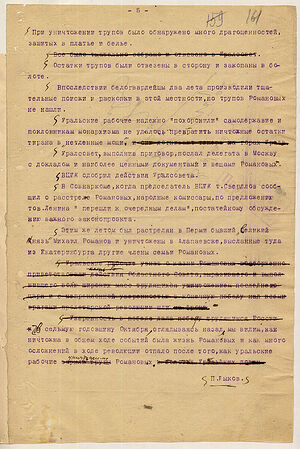 —Clothing and personal items were burned. Baftalovsky’s note is a very important testimony. Undoubtedly, the interest around this topic is so great that various people sprout up like mushrooms in the information space, clearly and colorfully expounding various theories. And amateur trackers—they are innumerable—sometimes write appalling nonsense. But people believe them, revere them, and look up to them. But there is another position, which was voiced by His Holiness Patriarch Kirill, and for us it is the only true and possible one: it is the path of painstaking work and conscientious scientific methods. I believe the truth will be voiced by the Russian Orthodox Church.
—Clothing and personal items were burned. Baftalovsky’s note is a very important testimony. Undoubtedly, the interest around this topic is so great that various people sprout up like mushrooms in the information space, clearly and colorfully expounding various theories. And amateur trackers—they are innumerable—sometimes write appalling nonsense. But people believe them, revere them, and look up to them. But there is another position, which was voiced by His Holiness Patriarch Kirill, and for us it is the only true and possible one: it is the path of painstaking work and conscientious scientific methods. I believe the truth will be voiced by the Russian Orthodox Church.
The first film—“Regicide: A Century-long Investigation”—is dedicated exclusively to the murder that was committed in the Ipatiev House. The second film—“Murder of the Romanovs: Facts and Myths,” which was shown thanks to the channel Russia-1 and the History of the Fatherland Foundation—covers a short period of time in the summer of 1918 and reveals a certain connection between three crimes. At first we had the idea of focusing more on each of the events and making an individual film for each—on Perm, Alapaevsk, and Ekaterinburg—and we could have gathered enough material for this. But, unfortunately, we were limited by screen time. So we tried to isolate the main points.
 Even now you can find opinions among the researchers dealing with the Romanovs that, for example, Alapaevsk (the murder of the Grand Duchess Elizabeth) and Perm (the murder of Grand Duke Michael) were both the decision of the local Council of People’s Commissars. Gabriel Myasnikov, for example, wrote an entire book about this. But when we went to Perm and started talking with people who work in the archives with the originals, we were presented a completely different picture. We were fortunate enough to meet some wonderful archivists.
Even now you can find opinions among the researchers dealing with the Romanovs that, for example, Alapaevsk (the murder of the Grand Duchess Elizabeth) and Perm (the murder of Grand Duke Michael) were both the decision of the local Council of People’s Commissars. Gabriel Myasnikov, for example, wrote an entire book about this. But when we went to Perm and started talking with people who work in the archives with the originals, we were presented a completely different picture. We were fortunate enough to meet some wonderful archivists.
—You managed to convey their very conscientious attitude to the work: It’s not just an academic interest, but a deep personal experience.
—People work for decades with great love for their inconspicuous but extremely important work, not expecting any encouragement or rewards. They know their topic incredibly well. As you have correctly noted, they perceive what happened as if it happened yesterday in front of their eyes. Just like us, they perceive these events very deeply, and I’m glad that our joint work on the film expands our circle of not only professional acquaintances, but also personal ones.
—The film provides a unique archival audio recording. How did you manage to get it?
—It’s a restored archival audio recording that was preserved as “top secret.” It just recently became available to researchers, and, indeed, it sheds light on many facts. Other materials are stored in the Russian state archive of socio-political history. Many storylines from this story were not included in the film. We would be happy to continue this work, but not before all the appointed examinations are finished. This is science, not the pursuit of spectacular sensations. Even if the resolution of the investigation doesn’t suit someone, or disappoints someone, or someone says: “No, it can’t be,” because some materials came from people who aren’t very churchy, for example—it’s still an insufficient argument.
—How much only the information trail from Geliy Ryabov is worth…
—Geliy Ryabov became a believer in much thanks to what happened. He spoke with Archpriest Alexander Shargunov and passed on some of his findings to him. We filmed Fr. Alexander for “Regicide: A Century-long Investigation.” Ryabov’s second wife told us a lot. All the circumstances of his story turned out to be simpler and more logical, and in the end, everything really falls into place, like pieces of a puzzle.1
The murder of Tsar Nicholas II is spoken of as a ritual act, but it would be more correct to speak of it as sacred; and I, as a researcher, cannot completely deny this. But to be fair, it should be said that when we were in New York, working with newspapers published before the revolutionary events of 1917, we came across cartoons in articles about Russia where the head of Emperor Nicholas II was drawn separately. Can be this be considered an argument for the theory about his decapitation? I don’t think so. Why would they have carried his head to Moscow, thus taking a completely unjustified risk, since random people could have witnessed it? And as you’ve probably already realized from the documents presented in our film, the last thing in the world Lenin and his cohorts wanted was to be connected with the murder of Emperor Nicholas—for political gain, of course. And these people knew how to appreciate benefits.
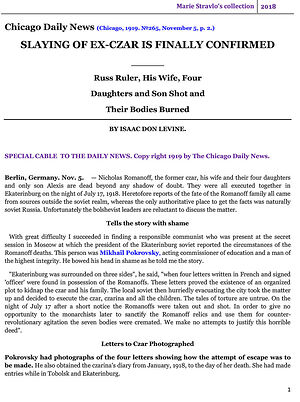 —In other words, the expression “sacred murder” has a symbolic meaning?
—In other words, the expression “sacred murder” has a symbolic meaning?
—The expression “sacred murder” is just not only in relation to the Sovereign Emperor Nicholas Alexandrovich, but first of all to Grand Duke Michael Alexandrovich, who in fact was the main contender for the Russian throne.
The reception of power was postponed until the Constituent Assembly was called. And if Kolchak had managed to win, no doubt the Constituent or National Assembly would have been called first. It’s quite likely that it would have called Michael Alexandrovich to head the state, because the dynasty was not interrupted. The Pavlovian laws (the Act of Succession of 1797) provided that if someone leaves, then another member of the dynasty is placed on the throne by force of law, “so the state wouldn’t be without heirs, so the heir would be appointed by the law itself, so there wouldn’t be even the slightest doubt as to who is to inherit, so as to preserve the right of birth in the inheritance, without violating the rights of the natural heir, and to avoid difficulties in the transition from generation to generation.”
 That’s why the murder of Grand Duke Michael Alexandrovich was first. The Bolsheviks weren’t sure of their position; they had to hurry. According to the documentary evidence, the greatest amount of disinformation was aimed at concealing the murder of Grand Duke Michael Alexandrovich.
That’s why the murder of Grand Duke Michael Alexandrovich was first. The Bolsheviks weren’t sure of their position; they had to hurry. According to the documentary evidence, the greatest amount of disinformation was aimed at concealing the murder of Grand Duke Michael Alexandrovich.
As bitter as it is to realize, investigator Sokolov and other researchers paid very little attention to the investigation in Perm. The official story is that it was a disappearance. A man disappeared. He was there, and then he suddenly disappeared. There was a lot of evidence that he was seen here and there, then in Harbin, then somewhere else. The officers swore they caught a glimpse of him in the crowd—a mass psychosis, an unwillingness to accept the reality. If Michael Alexandrovich is alive—no matter where—it means they have hope. And Russia has hope. Do you get it? This is a very deep motive. And it is this motive that can cast doubt on all such evidence taken together.
When we put the three murders in a line, a lot of things became obvious. At that time, the English Consul Preston—who reported in London on what was happening—was in Ekaterinburg, along with a mass of representatives of international organizations, including the American, Finnish, and Swedish Red Cross. It was full of outside observers. The Brest Peace, which was treasonous to Russia, had already been concluded. The Germans were sitting in the Council of People’s Commissars—just like the Americans sat in our government under Chubais2 a few decades later.
—There is the view that a “ticking time bomb” was placed under the edifice of the Russian state at this time. What do you think about this?
—I agree with this hypothesis. It’s no accident that the name “Union of Soviet Socialist Republics” doesn’t have the word “Russia” in it. An interesting fact: In August 1916 in Switzerland, there was a meeting of bankers from warring powers, including Germany, to which Russia was not invited.
 Russia was to be divided into spheres of influence according to the principle of divide and conquer. This would have been impossible to do under the existing monarchy. Lenin was entrusted with ensuring that Russia lose the war. The plan was to have Russia leave the war through the revolution and, as a result, violate the agreements with its allies about how no one warring party should conclude a separate peace treaty. This would automatically exclude Russia from the list of future winners, which is what happened. A massive information attack to discredit Tsar Nicholas II was carried out throughout the entire world. When we were dealing with this historical period for the film “Revolution: A Trap for Russia” and were communicating with English researchers, they said that in England society was even more certain than in Russia that revolution was coming in Russia, that the Tsaritsa was a German spy, and that everything was controlled by Gregory Rasputin, and so on. That’s how the propaganda worked.
Russia was to be divided into spheres of influence according to the principle of divide and conquer. This would have been impossible to do under the existing monarchy. Lenin was entrusted with ensuring that Russia lose the war. The plan was to have Russia leave the war through the revolution and, as a result, violate the agreements with its allies about how no one warring party should conclude a separate peace treaty. This would automatically exclude Russia from the list of future winners, which is what happened. A massive information attack to discredit Tsar Nicholas II was carried out throughout the entire world. When we were dealing with this historical period for the film “Revolution: A Trap for Russia” and were communicating with English researchers, they said that in England society was even more certain than in Russia that revolution was coming in Russia, that the Tsaritsa was a German spy, and that everything was controlled by Gregory Rasputin, and so on. That’s how the propaganda worked.
—One of the conclusions of your film is that the facts of the history are very malleable, and to establish the truth, we still have to reexamine and reevaluate our past. The question for modern man is: If this was done on such a scale and with such success, is it possible that the mechanism turning myths into facts is still active today?
—Of course. We see this in the example of our brothers in Ukraine, or if we look at what is happening in the United States right now. If we replace the word “proletariat” with “black,” we’ll get a traced copy of the events of a century ago in Russia. The scenery changes, but the rhetoric remains the same: “oppressors and the oppressed”—it’s nothing new.
There’s an expression: You have to accept your past, your successes, and your failures. It seems to me this is happening in Russia now. The best thing we can do is to accept the historical truth. It’s my Russia, and I accept its history as God gave it to us, to paraphrase Pushkin.

